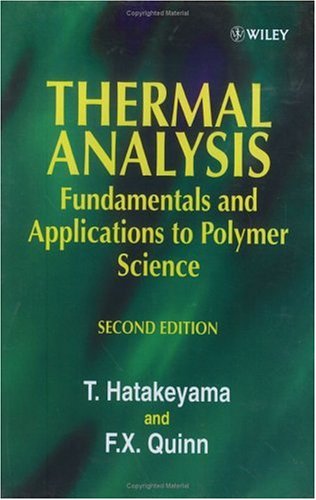T. Hatakeyama, F. X. Quinn9780471983620, 0-471-98362-4
Table of contents :
Cover Page……Page 1
Title Page……Page 2
Copyright © 1999 by John Wiley & Sons Ltd…….Page 3
3 Calibration and Sample Preparation……Page 4
5 Applications of Thermal Analysis……Page 5
6 Other Thermal Analysis Methods……Page 6
Subject Index……Page 7
Preface……Page 8
Preface to the Second Edition……Page 9
1.1 Definition……Page 10
1.2 Characteristics of Thermal Analysis……Page 11
1.4 Book Outline……Page 13
2.1 Differential Thermal Analysis (DTA)……Page 14
2.2 Quantitative DTA (Heat-Flux DSC)……Page 17
2.3 Triple-Cell Quantitative DTA……Page 19
2.4 Power Compensation Differential Scanning Calorimetry (DSC)……Page 20
2.5 Temperature Modulated DSC (TMDSC)……Page 21
2.6 High-Sensitivity DSC (HS-DSC)……Page 29
2.7 Data Analysis and Computer Software……Page 30
2.10 Installation and Maintenance……Page 31
2.11 References……Page 33
3.1 Baseline……Page 34
3.2 Temperature and Enthalpy Calibration……Page 37
3.3 Sample Vessel……Page 38
3.4 Sample Preparation……Page 41
3.5 Temperature Gradient in Sample……Page 45
3.6 Sample Packing……Page 48
3.8 Scanning Rate……Page 50
3.9 Sub-ambient Operation……Page 52
4.1 Introduction……Page 54
4.2 Thermobalance……Page 55
4.3 Temperature Calibration……Page 64
4.4 Sample……Page 67
4.5 Atmosphere……Page 70
4.6 Heating Rate……Page 72
4.7 Classification of TG Curves……Page 74
4.8 Calculation of Mass Change Rates……Page 75
4.10 Intercomparison of TG and DTA……Page 77
4.11 TG Reports……Page 79
4.12 References……Page 80
5.1 Temperature Measurement……Page 81
5.2 Enthalpy Measurement……Page 83
5.3 Reaction Rate Kinetics……Page 86
5.4 Glass Transition of Polymers……Page 99
5.5 Heat Capacity Measurement by DSC……Page 106
5.6 Heat Capacity Measurement by TMDSC……Page 109
5.7 Purity Determination by DSC……Page 111
5.8 Crystallinity Determination by DSC……Page 114
5.9 Molecular Rearrangement During Scanning……Page 115
5.10 Polymorphism……Page 116
5.12 Bound Water Content……Page 118
5.13 Phase Diagram……Page 122
5.14 Gel-Sol Transition……Page 124
5.15 References……Page 127
6.1 Evolved Gas Analysis……Page 128
6.2 Mechanical Analysis……Page 134
6.3 Dilatometry……Page 142
6.4 Thermomicroscopy……Page 145
6.6 Thermoluminescence (TL)……Page 148
6.7 Alternating Current Calorimetry (ACC)……Page 151
6.8 Thermal Diffusivity (TD) Measurement by Temperature Wave Method……Page 154
6.9 Thermally Stimulated Current (TSC)……Page 157
6.10 Thermal Conductivity……Page 161
6.11 Micro-thermal Analysis (μTA)……Page 162
6.12 Optothermal Transient Emission Radiometry (OTTER)……Page 163
6.13 Specific Heat Spectroscopy……Page 164
6.14 References……Page 165
Curie temperature: Temperature of transition from ferromagnetism to paramagnetism, or from a……Page 167
Dynamic mechanical analysis (DMA): Branch of thermal analysis where the behaviour of a sample……Page 168
Isothermal mode: Operating mode of TA instruments, where the response of the sample is monitored……Page 169
Quantitative differential thermal analyser: Instrument for measuring the difference temperature……Page 170
Thermal analysis (TA): Class of analytical methods where the nature of a sample is investigated in……Page 171
Thermomechanical analysis curve: Graphical representation of data collected by a thermomechanical……Page 172
Appendix 2—Standard Reference Materials……Page 173
Chemical Formula Index……Page 181
D……Page 184
G……Page 185
N……Page 186
Q,R……Page 187
T……Page 188
X,Y……Page 189







Reviews
There are no reviews yet.